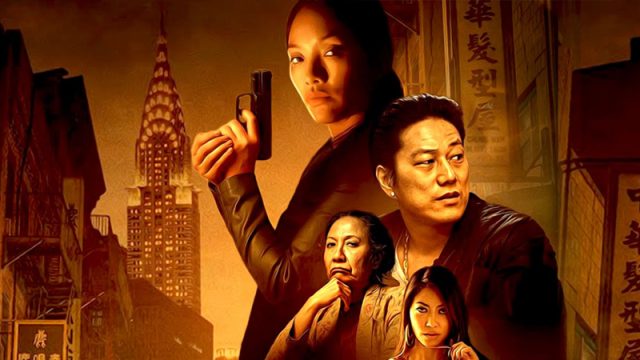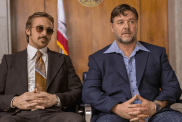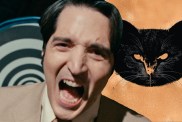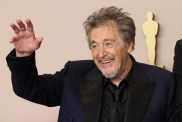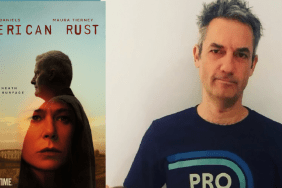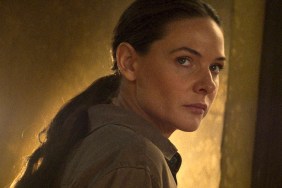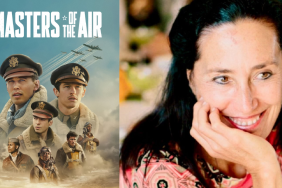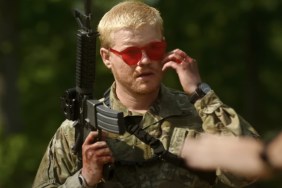The soundtrack for the NYC crime drama Snakehead by Roman Molino Dunn (a.k.a. Electropoint) is now available digitally from Mirrortone. The 22-track album features the artist’s gritty orchestral-electronic hybrid score, opening with a dark Venetian Waltz (“Chinatown”). The indie crime drama from director/writer Evan Jackson Leong (Linsanity) is now playing in theaters and VOD, courtesy of Samuel Goldwyn Films and Roadside Attractions.
ComingSoon.net spoke with Roman about his score for Snakehead and discussed his approach to the crime thriller.
Jeff Ames: I listened to your soundtrack and thought it was a really intense and brooding. The main theme is almost waltz-y. If that’s a good way to describe it?
Yeah, that was the whole concept of the theme was that it was supposed to be a dark waltz. It’s a crime drama and those are always a little bit romantic and alluring. Instead of going with traditional Chinese music we decided to go dark and romantic.
Yeah, that’s interesting. The main theme is haunting, but then always trails off to this sort of emotional finale.
Definitely, I’m glad that hit. That was definitely the message there. The big waltz stuff is Chinatown and the sad stuff is the human trafficking victims. And they’re kind of existing together. That’s what each of those themes were and they’re interrelated, so one always comes before the other and they interweave throughout the film.
So, stepping back a little, what initially drew you to Snakehead?
I had never worked with the director Evan [Jackson Leong] before. In my world, you get approached more than you approach the director. If I had known about this film without him approaching, I certainly would have tried to go after it. But he came to me and once I saw it I was hooked. From the onset, seeing the visual storytelling – because there’s a lot of great scenes without dialogue, and that’s not very common. They rely on dialogue and acting and while that certainly was a big part of his film, Evan was able to tell this sentimental and deep story through a visual narrative, just the shots or the editing of the shots together. When I saw that as a composer I was like, “Put me in coach!” It’s a chance for your music to be closely tied to the picture in a way that you don’t always get to do when it’s so dialogue-heavy.
But he approached me and he liked my previous work on this film called Huracán on HBO Max. And there are some similarities between this score and that score in that their hybrid – a mix of synthesizer and orchestra, but this one is far more romantic. To your point earlier of being enjoyable to listen to on its own, that’s because there were these long moments of no dialogue sequences because I could let the melodies speak. In Huracán I wasn’t able to do that because there’s so much dialogue.
Does the quality of a film impact your approach to it?
Yeah, sometimes not in the way you think. When it’s not as good a film, or let’s put it this way: if there are moments in the film where I think the acting wasn’t as strong, I feel very compelled to cover it up with music. [Laughs] To be honest, most of the films I’ve done are wall-to-wall music. I don’t know why that is, it’s probably because I like to write more music and have them cut it later if they don’t like something, but when there’s poor acting or when I don’t think something is very compelling I feel very motivated to add more prominent music to those moments.
What is the process of creating a hybrid score like Snakehead? I spoke with Marco Beltrami a few weeks back about his score for Venom: Let There Be Carnage and he mentioned that the electronic cues are written before the orchestrations. Is that a technique you follow as well?
I’ve done it the way Marco is talking about. But on this project in particular, because it’s such a hybrid, I’m actually doing something a little different where it’s not a hybrid necessarily in that sense where its orchestra mixed with synthesizer. Sometimes its orchestra played through synthesizer. So, what I mean is some of the cues you have this really dark harp. What I did was I recorded the harp into the synthesizer and then I played it back out. So, I’m creating electronic instruments using orchestral elements and then performing them for some of it. For other parts, I’m playing synthesizers or violins over the top of it. In this film, I play most of the orchestral elements myself. It’s because of that process I’m talking about where you get this hybrid of treating organic instruments through electronic processing and likewise putting synthesizers out through speakers as if they were an orchestra. So, kind of playing with all sorts of production techniques to get this kind of sound.
Was there a new instrument or tool that you had to utilize or familiarize yourself with on this score?
The answer is probably yes in the sense that recording a violin through a specific synthesizer, maybe I hadn’t used that exact synthesizer before. But I have employed this technique on the last couple of scores that I’ve done. So, yeah, it’s a pretty comfortable workflow for me. I don’t think there was one instrument that was new. I will say I’m not a great cellist but I had to play a lot of cello on this score.
I hear a lot of composers say they’re not great a playing a lot of instruments and yet they end up playing a lot of instruments in their scores. How do you work through that?
Well, a lot of editing! (Laughs) What’ll happen is, if I have a cue where I’m using a lot of synthesizer and I want to give it a hint of organic character to represent what’s happening on screen. Like maybe there’s an emotional moment but it’s mixed with something dark, I would have these really dark and gritty synthesizers, but I would also want the sound of a bow from a cello. So, I might play the sound of the cello but combine it with the more complicated parts on the synthesizer. So, you don’t always have to record the full virtuosic performance, but you’re getting elements to add to it.
Going back to what you said about staying away from Chinese instruments, can you elaborate on why you chose to go in a different direction?
Two reasons, I suppose. One was organically discovering this language. It wasn’t necessarily off the table, but it wasn’t really on the table. We were looking for something that represented the characters and their plight not necessarily what’s their cultural background. So, this is the music that made sense for the tone of the film or the color of the film. In any other film, you might not necessarily touch on someone’s cultural background, so we didn’t have to do that.
Now, the more purposeful reason for the director not to do it: he wanted to tell a unique story about the underworld of Chinatown and highlight strong matriarchal figures. The traditional representation in Hollywood of Chinese gangsters is cliched usage of Chinese traditional folk forms and folk instruments and that didn’t seem to make sense for a modern retelling for this Chinese American crime saga.
Was there a sequence or character or part of the film you found difficult to score?
Actually yes. Usually what’s difficult for me in most films is when there’s something really disturbing, something violent … that stuff is really hard emotionally. The hardest one in this film was, there’s a moment where the young girl is getting chased through Chinatown and it takes place during a festivity that happens in Chinatown every year. This actually was a moment where we used some traditional Chinese instruments because you see it onscreen. So, you see this lion dance, this march they do in Chinatown, and it’s beautiful.
It was shot so amazingly, but that was really difficult to score because it was this mixture of what people call source – a mixture of score and source music. We didn’t do anything source-y, you’re not hearing the live drums they’re playing, but I needed to do something close to that which was tense and all I could use was Chinese drums. It’s the only time in the film where there’s not pitched content. It’s all done with percussion instruments and this is the scene that took us the longest to score.
Speaking about you a little more, was there an artist or composer who influenced your style?
I spent the majority of my childhood studying renaissance and baroque music. I really really love renaissance music. The reason I love it, and it’s really pertinent to this film in some ways, is because of something called counterpoint, which is a musical texture where multiple melodies exist together as opposed to chords and a melody on top. It’s the interweaving of multiple melodies. Basically, it’s as close to 3D you can get in music. What’s helped me with that, particularly in film scoring, the melodies are often the themes for the characters. If you can interweave melodies and have them playing at the same time together, you can essentially carry out a drama musically. How it helped in this film was there were three themes going on – there was Chinatown, there was our protagonist and our antagonist; and their melodies play in counterpoint throughout the film.
Do you have any upcoming projects and is there a genre or series you would love to apply your musical style to at some point?
My next upcoming film is something called A.I. Love You and it’s a sci-fi rom-com that’ll be coming to Netflix sometime next year. I’m pretty excited about that. Very different from the last few pictures I’ve done.
As for a franchise, I would love to do a series for Netflix just because after doing a movie for them, I’m really excited about the reach that they have and the amount of people seeing and hearing their serial work.
